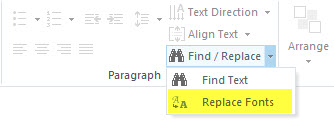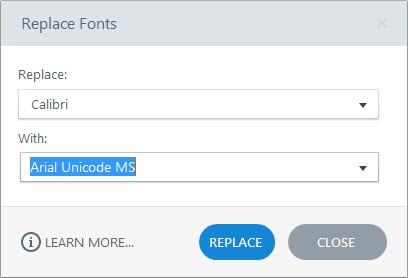Storyline 360 Adds Font Substitution for E-Learning Localization

3 Essential Qualities of an Accented English Voice-Over Talent
March 28, 2018
4 Cost-Saving Tips for Corporate & e-Learning Video Localization
April 11, 2018Most fonts don’t have multilingual support – this has always been a challenge for document, multimedia and e-Learning localization. Fortunately, desktop publishing and design applications have incorporated several features to deal with this issue. The latest is Articulate Storyline 360, which recently added a global font substitution interface, bringing a smile to the faces of multimedia localization professionals everywhere.
This post will review the new Storyline font substitution feature – and explain why it’s a big deal.
[Average read time: 3 minutes]
Why is font substitution even necessary for e-Learning localization?
Two big reasons.
First, despite the advent of Unicode and so-called universal fonts, most fonts don’t actually support multiple character sets. Even fonts that do have wider support – like Arial Unicode MS – don’t have great character renderings in some languages. Second, many e-Learning course developers and post-production video editors don’t even use universal fonts, opting instead for designer typefaces that definitely don’t cover non-Latin characters.
In short, if you’re localizing into languages that don’t use the Latin character set, you’ll almost certainly have to substitute the fonts in your e-Learning courses.
Why is this a big deal for Articulate Storyline?
Because font substitution in Storyline has been painful until now. So painful, in fact, that the best way to do it has been to output the translation strings from Storyline into a Word file. Localization editors could then use Word’s search-and-replace function, which covers fonts.
Want to see exactly how this process worked? Check out our previous post, Font Substitution in Articulate Storyline E-Learning Translation. It has an in-depth look at font substitution as well.
This glaring omission has always been surprising, in particular since Storyline has generally had excellent e-Learning localization support. For starters, its strings output feature and pre-localized templates are excellent. Moreover, its timeline includes features like markers that make synchronizing localized voice-over files more accurate and faster. And of course, its recent incorporation of SRT support adds subtitling as a cost-effective course localization option. It was just a matter of time until Storyline added font substitution to its robust feature set.
So how does it work?
First, on the HOME tab, go to the Paragraph section and click Find / Replace. (Make sure you have a slide open for editing – otherwise you won’t see this option.) Then, select Replace Fonts, as in the screenshot that follows:

You’ll get an interface which allows you to select each font used in your course, then substitute it globally. In the following screenshot, we’ve substituted Calibri with Arial Unicode MS:

Then click Replace. It’s that simple.
While this feature will shorten file prep timelines, it doesn’t get rid of all font issues. For example, Chinese and Japanese localization will still require manually switching out bolding for block fonts – Storyline still doesn’t support format substitution. And of course, localizing into right-to-left languages like Arabic and Hebrew will still require re-flows for courses that are heavily oriented from left to right – which is a good number of courses designed in the US.
Don’t forgot optimization for multimedia localization
In short, this feature doesn’t get rid of the need to design courses that are optimized for multimedia localization. That means that developers should avoid text embedded in graphics, keep the number of sync points with voice-over to a minimum, and stay away from strong left-to-right flows. While the features in Storyline and Adobe Captivate resolve most of the issues with legacy software like Flash, localization-friendly design is still the single best way to reduce project budgets and timelines – and maintain a high level of quality in your multilingual e-Learning courses.

